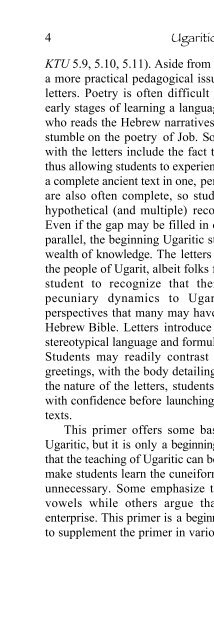A Primer on Ugaritic: Language, Culture, and Literature - enenuru
A Primer on Ugaritic: Language, Culture, and Literature - enenuru
A Primer on Ugaritic: Language, Culture, and Literature - enenuru
Create successful ePaper yourself
Turn your PDF publications into a flip-book with our unique Google optimized e-Paper software.
4<br />
<strong>Ugaritic</strong> <str<strong>on</strong>g>Primer</str<strong>on</strong>g><br />
KTU 5.9, 5.10, 5.11). Aside from this methodological issue, there is<br />
a more practical pedagogical issue that argues for beginning with<br />
letters. Poetry is often difficult to underst<strong>and</strong>, especially in the<br />
early stages of learning a language. Even an intermediate student<br />
who reads the Hebrew narratives in Genesis with c<strong>on</strong>fidence will<br />
stumble <strong>on</strong> the poetry of Job. Some other advantages to beginning<br />
with the letters include the fact that many of the letters are short,<br />
thus allowing students to experience the accomplishment of reading<br />
a complete ancient text in <strong>on</strong>e, perhaps lengthy, sitting. The letters<br />
are also often complete, so students do not have to begin with<br />
hypothetical (<strong>and</strong> multiple) rec<strong>on</strong>structi<strong>on</strong>s to fill in large gaps.<br />
Even if the gap may be filled in <strong>on</strong> the basis of another text or a<br />
parallel, the beginning <strong>Ugaritic</strong> student is not able to draw <strong>on</strong> this<br />
wealth of knowledge. The letters introduce the student to some of<br />
the people of Ugarit, albeit folks from the upper crust, <strong>and</strong> help the<br />
student to recognize that there are pers<strong>on</strong>al, political, <strong>and</strong><br />
pecuniary dynamics to Ugarit in additi<strong>on</strong> to the poetic<br />
perspectives that many may have heard about while studying the<br />
Hebrew Bible. Letters introduce students to issues of the use of<br />
stereotypical language <strong>and</strong> formulas al<strong>on</strong>gside “free-form” writing.<br />
Students may readily c<strong>on</strong>trast the stylized materials, such as<br />
greetings, with the body detailing some particular situati<strong>on</strong>. Given<br />
the nature of the letters, students learn a rather limited vocabulary<br />
with c<strong>on</strong>fidence before launching into the study of more difficult<br />
texts.<br />
This primer offers some basic resources for the student of<br />
<strong>Ugaritic</strong>, but it is <strong>on</strong>ly a beginning. There are many different ways<br />
that the teaching of <strong>Ugaritic</strong> can be approached. For example, some<br />
make students learn the cuneiform alphabet while others see it as<br />
unnecessary. Some emphasize the importance of rec<strong>on</strong>structing<br />
vowels while others argue that this is too hypothetical an<br />
enterprise. This primer is a beginning, <strong>and</strong> most teachers will want<br />
to supplement the primer in various ways (see Chapter 9).


